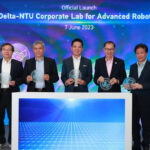ASIA ELECTRONICS INDUSTRYYOUR WINDOW TO SMART MANUFACTURING
Red Hat, Intel to Deliver Open-Source Industrial Automation in Shop Floors
Red Hat, Inc., the world’s leading provider of open-source solutions, announces a new industrial edge platform, designed in collaboration with Intel. Specifically, it aims to provide a modern approach to building and operating industrial controls.
The platform will transform the way manufacturers operate, scale, and innovate with standard IT technologies delivered to the plant floor and real-time data insights. Thus, it will enable industrial control system (ICS) vendors, system integrators (SIs), and manufacturers to automate previously manual industrial automation tasks. Among them are system development, deployment and management, cybersecurity risk reduction, and prescriptive and predictive maintenance improvements for factory agility. Also, it includes co-locating deterministic and non-deterministic workloads and reducing turnaround time.
Smart factories, or software-defined factories, are playing a crucial role in amplifying the speed at which manufacturers can innovate. According to a report by McKinsey, “Smart manufacturing has the potential to create up to $3.7 trillion in value by 2025, driving growth, innovation, and competitiveness across sectors.” By breaking down the barriers between IT and OT, manufacturers can embrace collaboration with new functionality and proactively strengthen and speed up operations, with the flexibility and intelligence to scale based on demand.

Mainly, the industrial edge platform is intended to provide a holistic solution that spans from real-time shop floor control and artificial intelligence/machine learning (AI/ML) to full IT manageability. Accordingly, it will deliver greater customer choice for data gravity or edge-to-cloud style architectures and improved overall equipment efficiency (OEE).
To continuously support this effort, Red Hat and Intel are working to integrate Intel-based platforms and Intel Edge Controls for Industrial (Intel ECI) with current and future versions of Red Hat Enterprise Linux. Mainly, this starts with collaboration in upstream Linux communities like the Fedora Project and CentOS Stream. Also, this collaboration extends to bringing these controls and platforms to Red Hat Device Edge (early access), Red Hat Ansible Automation Platform, and Red Hat OpenShift. With this collaboration organizations can benefit from:
- Fully integrated real-time capabilities from silicon to software, to support industrial automation for predictable performance;
- Advanced management and network automation for system deployment and management without heavy-handed resource usage. This simplifies the industrial network creation and management using open standards-based tools;
- Scalability and flexibility through a software-defined platform approach that facilitates more portable, scalable control and maximizes adaptability;
- Uninterrupted operations supported by high-availability and redundancy attributes built-in with the platform;
- Simplified AI workload integration with the ability to take an AI workload and run it next to a control workload, helping simplify hardware complexity, and enabling AI to more easily improve product quality, system uptime, maintenance needs and more;
- Enhanced cybersecurity posture by removing human error elements with automated patching and updates, an immutable operating system plane and a platform built on hardened, production-tested components.
To underpin this platform, Red Hat – in collaboration with Intel – will deliver a real-time kernel that provides lower latency and reduced jitter. Thus, it will help applications run repeatedly with greater reliability. This new industrial edge platform will be built on open standards and community-driven innovation. Also, thousands of developers globally will drive it, helping to drive more simplified integration with other hardware and software components. Additionally, core code transparency and a clear roadmap and release cycle help take the guesswork out of when new releases are available and their accompanying features.
Red Hat’s industry-leading enterprise developer support backs IT teams with a best-in-class developer toolchain. It brings greater deployment consistency regardless of deployment model or integrator. Thus, it further removes guesswork and choice paralysis around modern developer tooling.
Software-defined Factories in Action
Limitations of legacy industrial controls and siloed organizational structures have hampered manufacturing innovation for decades. With this new platform, organizations will benefit from an open-edge platform that allows simplified integration of components in an easy-to-use, reliable solution for industrial automation. Industry leaders like ABB and Schneider Electric and Codesys are already working to successfully implement new industrial edge platforms to build modern industrial controls.
Francis Chow, vice president and general manager, In-Vehicle Operating System and Edge, Red Hat, said “From transforming traditional IT infrastructures to helping software-defined vehicles deliver scalable digital solutions across industrial edge, Red Hat has a proven history in driving not just modernization across industries, but innovation. Now, Red Hat has set our sights on bringing that same level of transformation to manufacturing plants across the globe with a new edge platform with Intel. We believe that by helping converge both IT and operational technologies, the next industrial revolution can arrive sooner, more quickly and built on a backbone of open source software.”
Meanwhile, Christine Boles, vice president in the network and edge group and general manager of federal and industrial solutions, Intel, said, “For years, Intel and Red Hat have worked together to transform and support a range of industries. Bringing together Red Hat’s expertise in cloud-to-edge application platform delivery and Intel’s strength in edge-to-cloud compute platforms, including industrial hardware and software, will deliver the software-defined capabilities and transformation to meet the resilient, flexible and reliable requirements of today’s manufacturing.”




